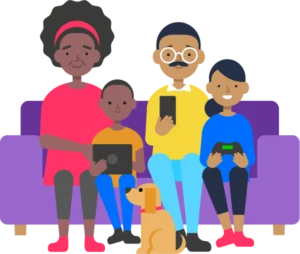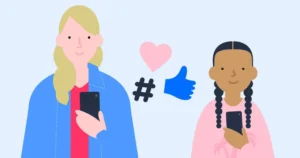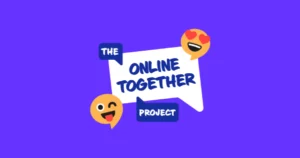Help LGBTQ+ children stay safe while socialising
Connecting with others and finding community is vital for LGBTQ+ youth. Help them do it safely with advice from experts.
Quick safety tips
Follow these top tips to help your LGBTQ+ child socialise and connect safely with others online.
Set parental controls
Manage who your child can speak to and who can contact them by setting parental controls on the apps and platforms they use.
Check-in regularly
Have regular conversations about how your child socialises online and with whom to reinforce messaging around safe behaviour online.
Discuss behaviour
Talk about healthy behaviours from them and others when using the online space to keep things positive and safe.
Inside this guide
- Challenges for LGBTQ+ children
- Benefits and risks
- How to prevent potential harm
- How to deal with harmful issues
- Activities to do together
Challenges for LGBTQ+ children
LGBTQ+ children are more likely to become the target of abuse online. Some challenges they might face include:
- homophobic or transphobic hate speech in spaces they enjoy;
- viewing inappropriate content or pornography which reinforces unhealthy behaviours or negative stereotypes;
- grooming and sexual exploitation directed at their sexuality or identity.
Benefits and risks for LGBTQ+ children
Life on social media is an important part of growing up today. For LGBTQ+ children and young people, it is often a lifeline.
Connections help young people educate themselves on their sexuality, or discover friends and connections with similar experiences. Connecting with others can also help them affirm they are not alone.
However, while all children face risks online, those who are a part of the LGBTQ+ community might experience unique risks.
Explore both benefits and risks to support LGBTQ+ children and young people’s safety in online social communities.
Benefits of socialising online
Finding community
Young people questioning their identity or struggling can find communities online to support them. This gives a sense of belonging they might not feel offline.
Authentic expression
The online space, and social media in particular, provides young people with the tools to authentically express themselves, especially if they struggle to do so offline.
Improving knowledge
With a wealth of community and information at their fingertips, LGBTQ+ young people can find people like them and develop their understanding of who they are without judgement.
Building relationships
Teenagers turn to the internet to learn about relationships, and dating through social media is becoming popular. LGBTQ+ teens can find comfort in building relationships in online spaces.
Risks of socialising online
LGBTQ+ young people can face many risks while socialising online. Generally, these risks fall into content and contact risks.
Content risks
Content risks are inappropriate things found in videos, images or text that children might come across online.
This might can include videos they watch independently or those suggested by algorithms, as well as comments seen on social media.
Inappropriate content poses risks online, including anti-LGBTQ+ messages and pornography. Most pornography presents a view of sex and relationships that are unhealthy or unrealistic. Unfortunately, this is even more true for LGBTQ+ relationships.
Anti-LGBTQ+ content can mislead young people exploring their identity, while pornography, often depicting control or violence, can distort their understanding of healthy relationships.
LGBTQ+ young people are at higher risk of cyberbullying and may encounter hateful content and speech online.
This can include text posts, homophobic or transphobic memes and videos. Social media algorithms can often enhance these messages, leading to children only experiencing these kinds of messages.
Without counter-messaging, children in the LGBTQ+ community might develop negativity towards their own self-image.
It’s important to note that their is risk of harm even if the messages aren’t directly calling out your child. Simply seeing others’ views on people like them can negatively impact their wellbeing.
Contact risks
Contact risks refers to communication from others online. This includes people your child knows as well as strangers, which can include scammers, exploiters and advertisers.
Communicating online can expose LGBTQ+ young people to risks, including homophobic individuals who might target them.
Other abusers might seek to groom your child, exploiting their sexuality and vulnerability. This could look like developing a friendship to talk through their struggles before eventually making demands.
Research from The Brook shows that gay youth are twice as likely to meet up with online contacts who are not who they said they were.
Additionally, abusers might exploit children’s vulnerability to extort nude images (sextortion). This is where they demand payment or more nudes under threat of sharing existing images with friends, family and peers. Sometimes, an abuser might create deepfake images first.
LGBTQ+ young people often face increased risk of sexual harassment and abuse online, including unwanted sexual behaviour such as unsolicited nude images.
Both strangers and peers from school can be perpetrators, and this behaviour can also occur between young people under 18.
How to prevent potential harm
Social media is now a part of growing up for many teens. Although there are many benefits to socialising online, especially for LGBTQ+ children and young people, there are also risks.
See what actions you can take and conversations you can have to protect your child as they socialise online.
Actions to take
Use family accounts
TikTok, Snapchat and Instagram all have teen accounts and family centres that you can use to monitor their time online. Use these features to help support safe socialising online.
Review together
Whatever platform they use, make them a part of the decisions when it comes to safety settings. Show them how to report and block (and when) to help them take ownership of their online safety and social interactions.
Balance screen time
Set limits and boundaries around social media use. For example, 1 hour daily limits or locking the device away at bedtime. This can help reduce the risk of harm while also promoting balanced device usage.
Find communities
Many LGBTQ+ young people see social media as a lifeline because they lack community offline and feel misunderstood expressing themselves. Help them find support safe and supportive groups online and offline.
Conversations to have
Regular conversations can help your LGBTQ+ child feel more comfortable about coming to you for help. Ask them about their online life like you would ask them about school.
Keep conversations casual and as a part of something you;re already doing like going for a drive or walking the dog.
Talk about what personal information means to them and clarify any misunderstandings. Before discussing oversharing, they need to understand what information should stay private.
Then, ask them if anyone has asked for any of this information. What did they do? Or, what could they do if it happened?
Ensure they know how to customise their social accounts and how to keep information private. This includes using safety settings but also avoiding sharing personal information in photos or posts. For example, a photo of themselves in their school uniform might tell viewers where they go to school.
Remember that LGBTQ+ young people often come out online first as well. While it might feel easier for them, and they will likely find support, some people might use that information to manipulate them.
Remember that LGBTQ+ children and young people will often learn about their sexuality in online spaces. People they communicate with could share misinformation or pornographic versions of relationships.
Discuss what is and isn’t healthy or realistic behaviour to help them make safe choices.
Additionally, address any awkward topics directly. This resource from CEOP can help.
Avoid indirect questions or leaving things open to interpretation. Be clear and ask questions. If you show that you’re uncomfortable, your child will likely pick up on it and feel the same.
Conversations around their favourite apps and communities can help you learn more about your child. Ask them how their favourite platforms support their wellbeing and what they do to stay safe.
Ask them to show you the platform if you don’t use it yourself. Or, if you do use it, ask which accounts you should follow. Exchanging funny videos or memes within the platform is a simple way that you can get involved with their interests.
How to deal with harmful issues
If your child experiences online harm while interacting with others online, take these steps to help them stay safe and build digital resilience.
- Report and block. Encourage your child to use blocking and reporting tools wherever something happens. They should also take screenshots and make note of accounts that target them. Depending on the severity and the perpetrators, you might need to report behaviour to police or your child’s school. This evidence will support this.
- Talk about the harm. Remember that conversation is one of the greatest tools you have as a parent. If something happens, talk it through with your child. Understand, though, that they might not want to talk, so explore other avenues such as counsellors or online forums like Ditch the Label. You should also find support for yourself.
- Keep checking in. Just because a harm is reported and dealt with, that does not mean the effects are gone. Some harms can have long-lasting effects. So, make sure you regularly check-in with your child about their online lives. Offer support and reassurance whenever you can.
Activities to do with your LGBTQ+ child
Improve your child’s online experience and teach them how to interact with others online safely using our activities below.

Get personalised advice and ongoing support
The first step to ensure your child’s online safety is getting the right guidance. We’ve made it easy with our ‘My Family’s Digital Toolkit.’





